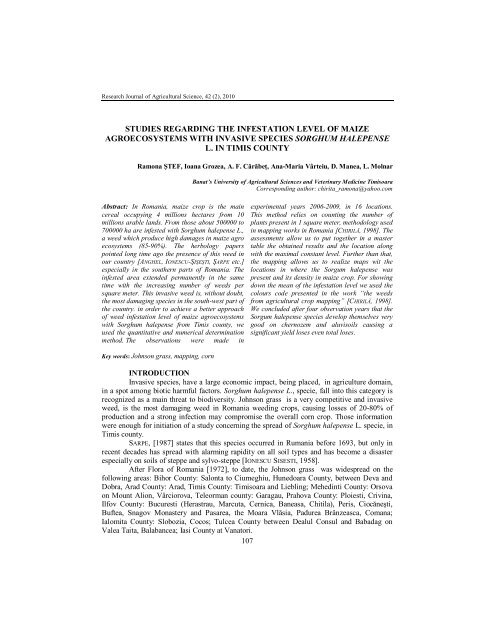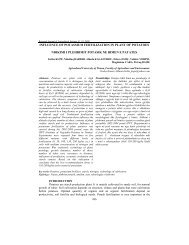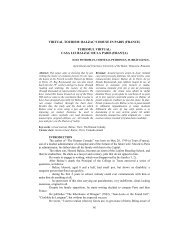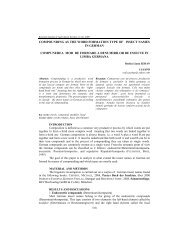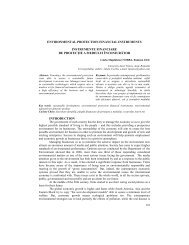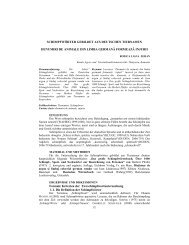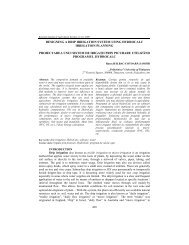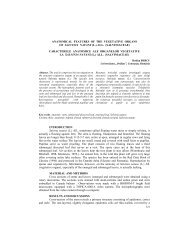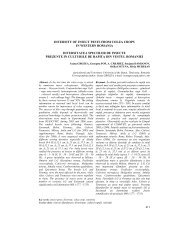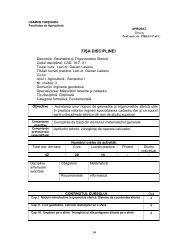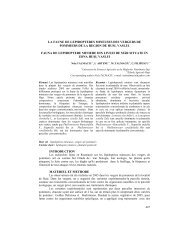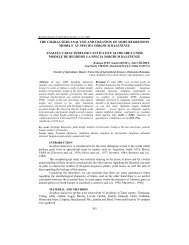03 Stef Ramona.pdf
03 Stef Ramona.pdf
03 Stef Ramona.pdf
Create successful ePaper yourself
Turn your PDF publications into a flip-book with our unique Google optimized e-Paper software.
Research Journal of Agricultural Science, 42 (2), 2010<br />
STUDIES REGARDING THE INFESTATION LEVEL OF MAIZE<br />
AGROECOSYSTEMS WITH INVASIVE SPECIES SORGHUM HALEPENSE<br />
L. IN TIMIS COUNTY<br />
<strong>Ramona</strong> ŞTEF, Ioana Grozea, A. F. Cărăbeţ, Ana-Maria Vârteiu, D. Manea, L. Molnar<br />
Abstract: In Romania, maize crop is the main<br />
cereal occupying 4 millions hectares from 10<br />
millions arable lands. From those about 500000 to<br />
700000 ha are infested with Sorghum halepense L.,<br />
a weed which produce high damages in maize agro<br />
ecosystems (85-90%). The herbology papers<br />
pointed long time ago the presence of this weed in<br />
our country [ANGHEL, IONESCU-ŞIŞEŞTI, ŞARPE etc.]<br />
especially in the southern parts of Romania. The<br />
infested area extended permanently in the same<br />
time with the increasing number of weeds per<br />
square meter. This invasive weed is, without doubt,<br />
the most damaging species in the south-west part of<br />
the country. in order to achieve a better approach<br />
of weed infestation level of maize agroecosystems<br />
with Sorghum halepense from Timis county, we<br />
used the quantitative and numerical determination<br />
method. The observations were made in<br />
Key words: Johnson grass, mapping, corn<br />
Banat’s University of Agricultural Sciences and Veterinary Medicine Timisoara<br />
Corresponding author: chirita_ramona@yahoo.com<br />
experimental years 2006-2009, in 16 locations.<br />
This method relies on counting the number of<br />
plants present in 1 square meter, methodology used<br />
in mapping works in Romania [CHIRILĂ, 1998]. The<br />
assessments allow us to put together in a master<br />
table the obtained results and the location along<br />
with the maximal constant level. Further than that,<br />
the mapping allows us to realize maps wit the<br />
locations in where the Sorgum halepense was<br />
present and its density in maize crop. For showing<br />
down the mean of the infestation level we used the<br />
colours code presented in the work “the weeds<br />
from agricultural crop mapping” [CHIRILĂ, 1998].<br />
We concluded after four observation years that the<br />
Sorgum halepense species develop themselves very<br />
good on chernozem and aluvisoils causing a<br />
significant yield loses even total loses.<br />
INTRODUCTION<br />
Invasive species, have a large economic impact, being placed, in agriculture domain,<br />
in a spot among biotic harmful factors. Sorghum halepense L., specie, fall into this category is<br />
recognized as a main threat to biodiversity. Johnson grass is a very competitive and invasive<br />
weed, is the most damaging weed in Romania weeding crops, causing losses of 20-80% of<br />
production and a strong infection may compromise the overall corn crop. Those information<br />
were enough for initiation of a study concerning the spread of Sorghum halepense L. specie, in<br />
Timis county.<br />
SARPE, [1987] states that this species occurred in Rumania before 1693, but only in<br />
recent decades has spread with alarming rapidity on all soil types and has become a disaster<br />
especially on soils of steppe and sylvo-steppe [IONESCU SISESTI, 1958].<br />
After Flora of Romania [1972], to date, the Johnson grass was widespread on the<br />
following areas: Bihor County: Salonta to Ciumeghiu, Hunedoara County, between Deva and<br />
Dobra, Arad County: Arad, Timis County: Timisoara and Liebling; Mehedinti County: Orsova<br />
on Mount Alion, Vârciorova, Teleorman county: Garagau, Prahova County: Ploiesti, Crivina,<br />
Ilfov County: Bucuresti (Herastrau, Marcuta, Cernica, Baneasa, Chitila), Peris, Ciocăneşti,<br />
Buftea, Snagov Monastery and Pasarea, the Moara Vlăsia, Padurea Brânzeasca, Comana;<br />
Ialomita County: Slobozia, Cocos; Tulcea County between Dealul Consul and Babadag on<br />
Valea Taita, Balabancea; Iasi County at Vanatori.<br />
107
Research Journal of Agricultural Science, 42 (2), 2010<br />
Johnson grass can often be seen in the south, but also in the west of the country and<br />
rarely in north-east, center and the north of the country.[ANGHEL et al., 1972; CIOCÂRLAN<br />
1978; POPA 1985; IONESCU et al., 1988; DIACONU 1990; BUDOI GH. et al., 1994; NEGRESCU et<br />
al., 1996; VILĂU et al., 1996]. Rarely appears as islands, on the rendzinic soil from north of<br />
Ploiesti [CHIRILĂ 1979; PINTILIE et al., 1984]. This specie is more abundant on chernozem<br />
soils with phreatic input or irrigated, on rendzinic soils and corn monoculture [ANGHEL et al.,<br />
1984].<br />
Sorghum halepense is also present in the western part of Timis and Arad county,<br />
being in expansion also on the hilly area especially on alluvial plain [GRIGORE et al., 1975;<br />
COSTE et al., 1996; COSTE 1998].<br />
In the mappings performed in Teleorman county was found that in north on the soil<br />
preluvosol were found on average five plants per m 2 , while in central and south, on the<br />
chernozem soils, the values exceeded 10 plants per m 2 . In an analysis made in Teleorman<br />
County on a route of 100 km from north to south, located between isotherms 10.5◦C 11.5◦C<br />
were recorded following such obvious differences: in the Tătărăştii de Jos were found 0,1 plant<br />
per m 2 , on Calinesti 6-7 plants per m 2 , in Alexandria 12 plants per m 2 , in Izvoarele 14.2<br />
plants per m 2 and in Zimnicea 12.6 plants per m 2 [ANGHEL et al., 1975], analyzed data<br />
demonstrate the thermophilic trait of analyzed specie.<br />
From research conducted by CHIRILA C. et al., [1978] in Prahova county results that<br />
the plant can be seen in all the land from south of the county and in several municipalities in<br />
the north-west, thus occupying a territory much larger than noted in Flora RSR VOL XII.<br />
Highest values are found at south and north-west of Ploiesti, on chernozem soils, gley soil and<br />
litomorph soils of rendzinic type, formed on deep deposits of limestone gravel.<br />
Figure 1 : Johnson grass spread in Romania<br />
In the counties of Constanta and Ialomita Sorghum halepense species frequency<br />
increases from north to south and the plains [ANGHEL et al., 1975].<br />
In the Insula Mare a Brailei, in 1974, Sorghum halepense was absent in the hill area<br />
and very poorly represented in other areas but in 1984 reached a density 13 times higher in<br />
monoculture and maintain at a high degree in rotations [POPA et al., 1988].<br />
108
Research Journal of Agricultural Science, 42 (2), 2010<br />
MIRIŢESCU, [1998] examined the degree of weeding in all 41 counties, in five met<br />
densities that overcome 100 copies per m 2 (Braila, Calarasi, Ialomita, Mehedinti and Olt), in<br />
seven counties met densities between 80 and 100 copies per m 2 (Bihor, Constanta, Dolj, Galati,<br />
Giurgiu, Gorj and Ilfov) and the other counties (Alba, Arad, Arges, Bacau, Bihor, Bistrita,<br />
Brasov, Braila, Buzau, Caras – Severin, Dambovita, Hunedoara, Iasi, Prahova, Satu Mare,<br />
Sibiu, Teleorman, Timis, Tulcea, Vaslui, Valcea, Vrancea)where the specie is present were met<br />
densities of 80 plants per m 2 .<br />
In the counties: Botosani, Cluj, Covasna, Harghita, Mures, Neamt, Salaj, Suceava<br />
Sorghum halepense specie was not not found [MIRIŢESCU, 1998].<br />
Analyzing existing data in the literature concerning the spread of Johnson grass , with<br />
those of MIRIŢESCU [ 1998], was found that the specie has continued, at a rapid rate, the<br />
advance to higher regions and inside the country. Thus the species is found in counties like<br />
Brasov and Sibiu, counties where before 1980 the species was not reported. Johnson grass<br />
spread in Romania is shown in figure 1. [CHIRILA, CIOCARLAN and BERCA, 2002].<br />
MATERIAL AND METHODS<br />
In order to knowledge of the cane spread current situation in crops in Timis County<br />
we performed determinations after quantitative, numerical method. This method consisted of<br />
counting Sorghum halepense specie, from the sample area (0.25 m 2 ), methodology used in the<br />
mapping weeds process in Romania [CHIRILA, 1989]. It is an expedient and sufficiently<br />
accurate method. Mapping work involved two phases: a field phase and a data processing<br />
phase.<br />
Mapping the Sorghum halepense L. specie has been made in agroecosystems between<br />
13 to 30 May, cane plants being phenophase BBCH 12 BBCH 15 (under uniform decimal code<br />
for wheat). In the four experimental years the number localities where observations were made<br />
was variable (10-19 locations). Observations concerning the spread of Sorghum halepense<br />
specie were made on different subtypes of chernozem.<br />
Determinations allowed the preparation of a summary table including the localities of<br />
Timis where the invasive specie Sorghum halepense L. was observed and maximum level<br />
found.<br />
A map was also drawn, including locations in the county where Sorghum halepense L.<br />
was found and also existing densities in corn crop.<br />
To highlight the average number of weeds color code presented in paper work<br />
“Mapping weed in field crops” was used [CHIRILA, 1989].<br />
colorless - under 20 pl/m2;<br />
Yellow - between 21 -40 pl/m2;<br />
Blue - between 41-60 pl/m2;<br />
Green - between 61-80 pl/m2;<br />
Dark Blue - between 81-100 pl/m2;<br />
Red - 100 pl/m2.<br />
RESULTS AND DISCUSSIONS<br />
In 2006 the experimental year observations were made in ten localities from Timis<br />
County, concerning the infestation of cane, in corn agroecosystems. These observations were<br />
aimed to obtain a synthetic image of weeding in maize crops from Timis County. Quantitative<br />
numerical mappings were made in May (29/05/2006) cane plants were in stage BBCH 12. The<br />
recorded data are presented in table 1.<br />
Following the study was noted that the largest number of cane plants per m 2 was in<br />
locality Foeni (34 plants/m 2 ), precipitations recorded in this locality have reached flood level.<br />
109
Research Journal of Agricultural Science, 42 (2), 2010<br />
The average degree of weeding in corn crop from the 10 localities in the study was 7.2<br />
plants/m 2 .<br />
Table 1.<br />
Spreading of Johnson grass in Timiş county, in experimental year 2006<br />
Localities Species Growth stage<br />
110<br />
Measurements<br />
1 2 3<br />
s m Cl. period Group<br />
ŞANDRA Sorghum halepense A 3 3 3 9 3 M.p XXVII<br />
SĂCĂLAZ Sorghum halepense A 6 6 6 18 6 M.p XXVII<br />
CĂRPINIŞ Sorghum halepense A 4 4 4 12 4 M.p XXVII<br />
FOENI Sorghum halepense A 34 34 34 102 34 M.p XXVII<br />
BILED Sorghum halepense A 12 12 12 36 12 M.p XXVII<br />
ŞANDRA Sorghum halepense A 3 3 3 9 3 M.p XXVII<br />
CARANI Sorghum halepense A 3 3 3 9 3 M.p XXVII<br />
BĂRĂTEAZ Sorghum halepense A 3 3 3 9 3 M.p XXVII<br />
GĂTAIA Sorghum halepense A 2 2 2 6 2 M.p XXVII<br />
TIMIŞOARA Sorghum halepense A 2 2 2 6 2 M.p XXVII<br />
AVERAGE 7,20<br />
Observations concerning the degree of Sorghum halepense L. infestation in corn<br />
agroecosystems continued in 2007, performing the quantitative numerical mappings in 12 cities<br />
in Timis County (table 2).<br />
Table 2.<br />
Spreading of Johnson grass in Timiş county, in experimental year 2007<br />
Localities Species<br />
Growth Measurements<br />
stage 1 2 3<br />
s m<br />
Cl.<br />
period<br />
LUGOJ Sorghum halepense A 1 6 2 9 3 M.p XXVII<br />
GRABAŢI Sorghum halepense A 24 20 16 60 30 M.p XXVII<br />
CĂRPINIŞ Sorghum halepense A 15 66 45 126 42 M.p XXVII<br />
DUDEŞTII VECHI Sorghum halepense A 4 2 1 7 2,33 M.p XXVII<br />
BILED Sorghum halepense A 5 0 1 6 2 M.p XXVII<br />
ŞANDRA Sorghum halepense A 42 17 47 106 35,33 M.p XXVII<br />
LOVRIN Sorghum halepense A 7 0 44 51 17 M.p XXVII<br />
BECICHERECU MIC Sorghum halepense A 2 9 0 11 3,66 M.p XXVII<br />
GOTLOB Sorghum halepense A 1 7 0 8 2,66 M.p XXVII<br />
JIMBOLIA Sorghum halepense A 7 6 1 14 4,66 M.p XXVII<br />
SÂNNICOLAU MARE Sorghum halepense A 12 1 0 13 4,33 M.p XXVII<br />
TIMIŞOARA Sorghum halepense A 16 26 0 42 14 M.p XXVII<br />
AVERAGE 13,41<br />
Largest number of cane plants per m 2 was recorded in localities Carpinis (42<br />
plants/m 2 ), Sandra (35.33 plants/m 2 ), Grabati (30 plants/m 2 ). Average number of cane plants<br />
per m 2 obtained in 2007 experimental year was 13.41 plants/m 2 .<br />
The results obtained concerning the degree of cane infestation in corn crop in 2008,<br />
are presented in table 3.<br />
Largest number of cane plants per m 2 was recorded in localities Sandra (181.2<br />
plants/m 2 ) Dudeştii Vechii (151.6 plants/m 2 ) Becicherecu Mic (151.6 plants/m 2 ). Lowest<br />
number of cane plants per m 2 was obtained in the area of Jimbolia (24 plants/m 2 ).<br />
Following mappings performed in 2008 experimental year, an average of 71.96 cane<br />
plants /m2, resulted.<br />
In Table 4. are given numerical results achieved in terms of degree of weeding in<br />
maize crops from 19 villages in Timis County, studied in 2009 experimental year.<br />
In corn agroecosystems from Jimbolia area an average number of 121 plants/m 2 was<br />
recorded. From the data results that Sorghum halepense specie was reported as present only in<br />
maize crops from Carani and Calacea localities.<br />
Figure 2 represents the average degree of cane weeding in maize agroecosystems of<br />
Timis county, in the four years of observations (27.23 plants/m 2 ).<br />
Group
Research Journal of Agricultural Science, 42 (2), 2010<br />
Localities Species<br />
Spreading of Johnson grass (weeds/m 2 ) in Timiş county, in year 2008<br />
Growt<br />
h stage<br />
Measurements<br />
1 2 3 4 5<br />
111<br />
s m<br />
K<br />
%<br />
Cl.<br />
period<br />
Table 3.<br />
VOITEG Sorghum halepense A 140 8 44 64 67 323 64,6 100 M.p XXVII<br />
GĂTAIA Sorghum halepense A 36 76 80 32 96 320 64,0 100 M.p XXVII<br />
BIRDA Sorghum halepense A 60 68 28 60 44 260 52,0 100 M.p XXVII<br />
JEBEL Sorghum halepense A 52 28 44 39 43 206 41,2 100 M.p XXVII<br />
LUGOJ Sorghum halepense A 16 16 76 20 52 180 36 100 M.p XXVII<br />
GRABAŢI Sorghum halepense A 28 84 36 40 58 246 49,2 100 M.p XXVII<br />
CĂRPINIŞ Sorghum halepense A 28 68 28 32 50 206 41,2 100 M.p XXVII<br />
DUDEŞTII VECHI Sorghum halepense A 88 236 132 98 204 758 151,6 100 M.p XXVII<br />
BILED Sorghum halepense A 156 4 80 16 64 320 64 100 M.p XXVII<br />
ŞANDRA Sorghum halepense A 108 328 340 96 34 906 181,2 100 M.p XXVII<br />
LOVRIN Sorghum halepense A 136 36 20 34 94 320 64,0 100 M.p XXVII<br />
BECICHERECU MIC Sorghum halepense A 380 64 28 93 221 758 151,6 100 M.p XXVII<br />
GOTLOB Sorghum halepense A 128 28 36 60 65 317 63,4 100 M.p XXVII<br />
JIMBOLIA Sorghum halepense A 58 16 20 8 18 120 24 100 M.p XXVII<br />
BUZIAŞ Sorghum halepense A 60 13 24 41 57 195 39 100 M.p XXVII<br />
CHEVEREŞ Sorghum halepense A 89 72 30 37 22 250 50 100 M.p XXVII<br />
TIMIŞOARA Sorghum halepense A 47 120 104 41 121 433 86,6 100 M.p XXVII<br />
AVERAGE 71,96<br />
Spreading of Johnson grass in Timiş county, in experimental year 2009<br />
Group<br />
Table 4.<br />
Localities Species Growth stage<br />
Measurements<br />
1 2 3<br />
s m<br />
Cl.<br />
period<br />
Group<br />
LOVRIN Sorghum halepense A 1 1 1 3 1 M.p XXVII<br />
SÂNNICOLAU MARE Sorghum halepense A 21 21 21 63 21 M.p XXVII<br />
ŞANDRA Sorghum halepense A 41 41 41 123 41 M.p XXVII<br />
GIARMATA Sorghum halepense A 2 2 2 6 2 M.p XXVII<br />
REMETEA MARE Sorghum halepense A 1 1 1 3 1 M.p XXVII<br />
DUDEŞTII VECHI Sorghum halepense A 1 1 1 3 1 M.p XXVII<br />
JAMU MARE Sorghum halepense A 1 1 1 3 1 M.p XXVII<br />
BECICHERECU MIC Sorghum halepense A 14 14 14 42 14 M.p XXVII<br />
PERIAM Sorghum halepense A 23 23 23 69 23 M.p XXVII<br />
VARIAŞ Sorghum halepense A 1 1 1 3 1 M.p XXVII<br />
CARANI Sorghum halepense A x x x x x M.p XXVII<br />
CALACEA Sorghum halepense A x x x x x M.p XXVII<br />
JIMBOLIA Sorghum halepense A 121 121 121 363 121 M.p XXVII<br />
CENAD Sorghum halepense A 1 1 1 3 1 M.p XXVII<br />
GIULVĂZ Sorghum halepense A 4 4 4 12 4 M.p XXVII<br />
JEBEL Sorghum halepense A 4 4 4 12 4 M.p XXVII<br />
GRABAŢI Sorghum halepense A 21 21 21 63 21 M.p XXVII<br />
TOPOLOVĂŢ Sorghum halepense A 1 1 1 3 1 M.p XXVII<br />
TIMIŞOARA Sorghum halepense A 20 20 20 60 20 M.p XXVII<br />
AVERAGE 16,35<br />
Figures 3, 4, 5, 6 represents analytic maps (presents spread in a given territory of a<br />
single species or a single group of weeds) of Sorghum halepense specie in Timis County.<br />
In the four years of observations in maize agroecosystems, from Timis county, was<br />
concluded that cane grows very well on chernozem and alluvial soils causing an significant<br />
reduction and even compromising the crop. Species is in an obvious expansion both in the area<br />
and in the weeding of the sole. The phenomenon is favored by increasing areas of land left<br />
fallow, the reduction of weed hoeing as a result of applying herbicide with substances based on<br />
Atrazin (not affecting the cane rhizomes) and monoculture of hoes. Another reason<br />
contributing to the spread of cane on less infested land is that exudates from the leaves,
Research Journal of Agricultural Science, 42 (2), 2010<br />
rhizomes and roots of this species have a strong inhibitory effect on seed germination of many<br />
other plants, thereby Sorghum halepense specie becoming a dominant [LITTLE, 1972 ].<br />
The average weeds<br />
2009<br />
2008<br />
2007<br />
2006<br />
7,2<br />
13,41<br />
16,35<br />
27,23<br />
112<br />
71,96<br />
Figure 2. – The average of weed infestation in maize, Timiş county<br />
Figure 3. - Synthetic map of Sorghum halepense<br />
specie, in 2006 experimental year<br />
Legenda<br />
< 20 pl/m 2<br />
21 – 40 pl./m 2<br />
41 – 60 pl/m 2<br />
Nr. pl/m2<br />
Figure 4. - Synthetic map of Sorghum halepense<br />
specie, in 2007 experimental year<br />
61 – 80pl./m 2<br />
81 – 100 pl. /m 2<br />
> 100 pl./m 2
Research Journal of Agricultural Science, 42 (2), 2010<br />
Figure 5. - Synthetic map of Sorghum halepense<br />
specie, in 2008 experimental year<br />
113<br />
Figure 6. - Synthetic map of Sorghum halepense<br />
specie, in 2009 experimental year<br />
CONCLUSIONS<br />
Area of agricultural territory where the cane weed is found has continuously<br />
increased, parallel with the finding a growing number of exemplars on m 2 (27.23 plante/m 2 ).<br />
High degree of weeding recorded in corn agroecosystems, in Timis County, is explained<br />
through that cane plants had a favorable development environment with regard to soil reaction<br />
and soil type (observations were made on different subtypes of chernozem). It requires serious<br />
action to locate the infestation and control it in all units.<br />
BIBLIOGRAPHY<br />
1. ANGHEL et al., 1972- ANGHEL şi col., 1957 – Determinarea calităţii seminţelor, Editura Academiei<br />
Române, Bucureşti;<br />
2. ANGHEL GH. şi col., 1984 – La distribution geographique de l'espèce Sorghum halepense (L.) Pers.<br />
Dans le sud – est de la Roumanie. Acta Botanica Horti Bucurestiensis<br />
3. ANGHEL şi col., 1975 – Botanică, Editura Didactică şi Pedagogică, Bucureşti;<br />
4. BUDOI GH. şi col., 1994 – Herbologia aplicată, buruienile şi combaterea lor, Editura Ceres, Bucureşti;<br />
5. CHIRILĂ C., 1978 – Răspândirea speciei Sorghum halepense în culturile agricole din judeţul Prahova,<br />
Lucrări Ştiinţifice, seria A, Vol. XX-XXI, Bucureşti, pag. 49-52;<br />
6. CHIRILĂ C., 1998 – Principalele buruieni din culturile agricole din România, Al X – lea Simpozion<br />
Naţional de Herbologie, Sinaia<br />
7. CHIRILĂ C., CIOCÂRLAN V., BERCA M., 2002 – Atlasul principalelor buruieni din România, Editura<br />
Ceres, Burureşti;<br />
8. CHIRILĂ C.,2001 – Biologia buruienilor, Editura Ceres, Bucureşti;<br />
9. CIOCÂRLAN V., 1978 – Bemerkungen über die verbreitung und ökologie der bedeutendsten<br />
segetalarten im Constanţa, România, Acta Botanica Slovaca, Acad. Slovacae, ser. A,<br />
nr. 3, pag. 117-125;<br />
10. COSTE I. şi col., 1996 – Îmburuienarea culturilor de legume în sud-vestul României, Al X – lea<br />
Simpozion Naţional de Herbologie, Sinaia, pag. 141-150;
Research Journal of Agricultural Science, 42 (2), 2010<br />
11. COSTE I., 1998 – Îmburuienarea plantaţiilor de viţă de vie în sud-vestul României (Banat), Al XI –<br />
Simpozion Naţional de Herbologie, Sinaia, pag. 117-122;<br />
12. DIACONU P., 1990 – Dinamica îmburuienării cerealelor de toamnă în condiţii de erbicidare – jud.<br />
Vrancea, Combaterea integrată a buruienilor, Târgovişte, pag. 81-89;<br />
13. GRIGORE S. şi col., 1975 – Cartarea buruienilor din culturile agricole în judeţele Timiş şi Arad,<br />
Cereale şi Plante Tehnice nr. 3, pag. 26-29;<br />
14. IONESCU FL., ŞARPE N., NICOLESCU M., PĂUNESCU G., STANCU ILEANA, FEROIU A., DULGHERU V.,<br />
UNGUREANU F., STROE S., CRISTEA M., 1988 – Combaterea costreiului din rizomi din<br />
culturile de soia de la I.A.S., Băileşti – judeţul Dolj, Al VI-lea Simpozion Naţional de<br />
Herbologie - Combaterea integrată a buruienilor, Bucureşti, pag. 111-118;<br />
15. IONESCU-ŞIŞEŞTI GH., 1958 – Agrotehnica, Editura Agrosilvică, Bucureşti;<br />
16. LITTLE E., 1972 – Însuşirile caracteristice şi metodele de combatere ale costreiului- Sorghum<br />
halepense L. (Pers.), Cereale şi plante tehnice, nr. 7, pag. 27-36;<br />
17. MIRIŢESCU M., 1998 – Cercetări asupra biologiei şi combaterii speciei Sorghum halepense (L.) Pers.,<br />
Teză de doctorat, Bucureşti;<br />
18. NEGRESCU A. şi col., 1996 – Tehnici de întreţinere a solului şi de combatere a buruienilor din<br />
plantaţiile de gutui situate pe solurile nisipoase din Oltenia, Al X-lea Simpozion<br />
Naţional de Herbologie, Sinaia, pag. 191-197;<br />
19. PINTILIE C. şi col., 1984 – Principalele buruieni şi combaterea lor, costreiul (Sorghum halepense),<br />
Cereale şi Plante Tehnice, nr. 7, pag. 29-31;<br />
20. POPA FANA şi col., 1988 – Buruienile din cultura porumbului şi combaterea lor pe terenurile din Insula<br />
Mare a Brăilei, Combaterea integrată a buruienilor, Bucureşti, 80-88;<br />
21. POPA FANA, 1985 – Observaţii asupra modificării gradului de îmburuienare în culturile de porumb şi<br />
soia în perioada 1974-1984, pe solurile din incintele îndiguite, Cereale şi Plante<br />
Tehnice, nr. 3, 267-281;<br />
22. ŞARPE N., 1987 – Aplicarea corectă a erbicidelor pe vegetaţie (postemergent) la cultura soiei, pentru<br />
combaterea buruienilor dicotiledonate şi a costreiului, Cereale şi Plante Tehnice, nr. 2,<br />
40-44;<br />
23. VILĂU N. şi col., 1996 – Noi rezultate privind efectul erbicidelor în combaterea buruienilor din cultura<br />
porumbului cultivat pe solurile cernoziomice din sudul ţării, Al X-lea Simpozion<br />
Naţional de Herbologie, Sinaia, pag. 249-264;<br />
24. *** 1972 – Flora României, vol. XII, Editura Academiei Române, Bucureşti, 57;<br />
114


